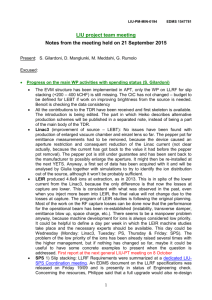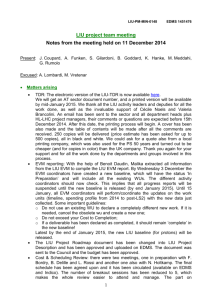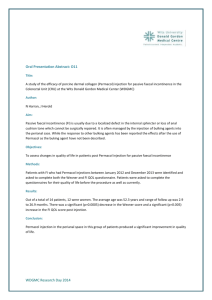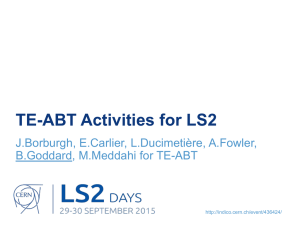Status of SPS injection and planning proposal - Indico
advertisement
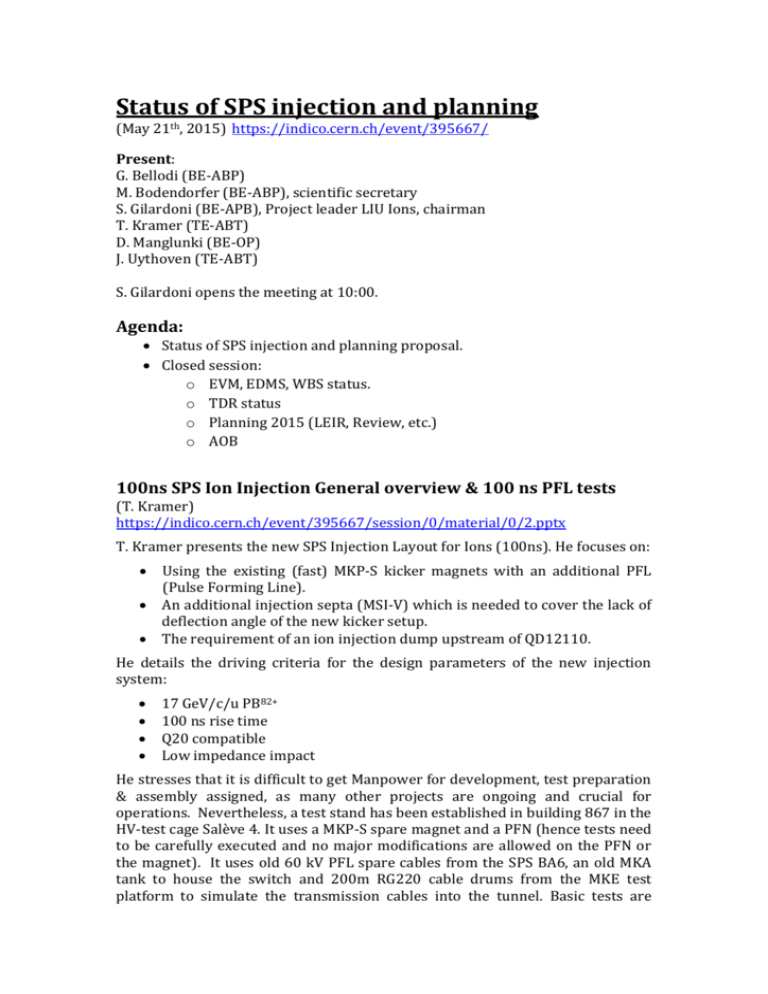
Status of SPS injection and planning (May 21th, 2015) https://indico.cern.ch/event/395667/ Present: G. Bellodi (BE-ABP) M. Bodendorfer (BE-ABP), scientific secretary S. Gilardoni (BE-APB), Project leader LIU Ions, chairman T. Kramer (TE-ABT) D. Manglunki (BE-OP) J. Uythoven (TE-ABT) S. Gilardoni opens the meeting at 10:00. Agenda: Status of SPS injection and planning proposal. Closed session: o EVM, EDMS, WBS status. o TDR status o Planning 2015 (LEIR, Review, etc.) o AOB 100ns SPS Ion Injection General overview & 100 ns PFL tests (T. Kramer) https://indico.cern.ch/event/395667/session/0/material/0/2.pptx T. Kramer presents the new SPS Injection Layout for Ions (100ns). He focuses on: Using the existing (fast) MKP-S kicker magnets with an additional PFL (Pulse Forming Line). An additional injection septa (MSI-V) which is needed to cover the lack of deflection angle of the new kicker setup. The requirement of an ion injection dump upstream of QD12110. He details the driving criteria for the design parameters of the new injection system: 17 GeV/c/u PB82+ 100 ns rise time Q20 compatible Low impedance impact He stresses that it is difficult to get Manpower for development, test preparation & assembly assigned, as many other projects are ongoing and crucial for operations. Nevertheless, a test stand has been established in building 867 in the HV-test cage Salève 4. It uses a MKP-S spare magnet and a PFN (hence tests need to be carefully executed and no major modifications are allowed on the PFN or the magnet). It uses old 60 kV PFL spare cables from the SPS BA6, an old MKA tank to house the switch and 200m RG220 cable drums from the MKE test platform to simulate the transmission cables into the tunnel. Basic tests are made and planned with the PFL, the MKA switch and the RG220 test cable drums pulsing into MKP to proof 100ns rise time of the PFL. Extended tests are planed to include a low impedance connection of the PFL and the PFN to the TX-cables. This is the actually challenging part of the whole test. Also tests with different options (Diode / 2nd Thyratron) are planed. T. Kramer presents two options: Option 1: Only 1 MS Thyratron with 2 passive diode stacks. An open question with this design is, how much the rise time is affected by the diode stack and whether the PFN clipper switch action is affected. Option 2: 2 MS Thyratrons (requiring also resources for controls, trigger, heaters, protection circuits etc.). With this design the 2nd Thyratron sees full backward voltage. However, this design promises a faster rise time than option 1. He presents first results from the tests. 1ms charging time is measured and a rather long droop. He also shows measurements from the MKA pulsing into the TMR via short Tx cables. With this non-optimized circuit he has achieved a rise time of 166ns. He has observed large perturbations from the thyratrons at the start of the rising edge. Furthermore he presents measurement results from the MKA (with Diode) pulsing into the MKP via long Tx cables. With this, non-optimized setup the rise time is about 280ns. Perturbations at the rising edged are still seen at the magnet entrance. The next steps planed are, to prepare the test stand (MKA) for Option 2 (2 Thyratrons). FTEC will start working on this topic from July 2015. The circuits will be simulated to get the best filter values. Furthermore, a low inductance connection to PFN will be designed. Rise time and ripple measurements will be performed and the circuits will be optimized. This includes precise measurements of the magnet (integrated) field. A decision on the feasibility will be taken in September. An engineering note will follow. S.Gilardoni and D.Manglunki comment that ripples on the flat top will not dominate the emittance blow up in the SPS. The latter is dominated by IBS. J. Uythoven comments that the work can be easily overviewed and no significant concerns exit. He states that the project could be finished within a couple of months with a straightforward schedule. S. Gilardoni stresses the need for a proof of principle as soon as possible. Status of SPS injection and planning proposal (J. Uythoven) https://indico.cern.ch/event/395667/session/0/material/0/0.pptx J. Uythoven summarizes the Project progress so far by: Project presented at LIU Ions – SPS Injection meeting on 12/02/2015 https://indico.cern.ch/event/373982/ Since then further work was done on the 100 ns fast kicker by T.Kramer Cost & Schedule Review 9. – 11. March 2015: SPS injection upgrade ‘cut’, not to be installed in LS2. Functional Spec v2 almost ready for publication: Assume 20 % budget for emittance growth during the injection process and septum ripple defined. Details about the upgrade of the SPS ion injection system: https://jacowfs.jlab.org/conf/proceedings/IPAC2015/papers/thpf099.pd f He presents the further activities as: Functional Spec v2 should be out in June. Integrate that it is confirmed that TIDVG will move to LSS5 in LS2. Extract information from FS to TDR. Engineering Specification on MSI-V also in June. Finish lab development and feasibility study of the 100ns PFL. Engineering specification should be ready by October. The rest of the project stays on hold until further news (and budget) about the possible installation after LS2 is received from the management. If installation in a YETS will be foreseen, certain preparation might be required in LS2 (Dummy chamber for injection dump, strip-line for MSI-V power converter, cabling for MSI-V). He stresses that the above work will only get started after the official green light is received. S.Gilardoni mentioned that the end of 2015 might be a good point in time to find out whether or not the installation may take place after LS2. All agree on the fact that, if the green light is received for the installation in a YETS, lots of preparatory work needs to be completed before the actual installation and a large part most likely in LS2. To be on the safe side, 2 years of anticipation are necessary to prepare the project for a possible green light for installation after LS2. D. Manglunki asks how realistic a possible installation might be outside the long shutdowns. J. Uythoven replies that during LS2, the beam dump will be removed. The lower radiation level will make access and a possible installation much quicker and easier to organize. Closed session (S. Gilardoni, D. Manglunki, G. Bellodi, M. Bodendorfer) The following points are announced and conversed about: Alexander Huschauer is definitively approved as fellow for LEIR. Each Wednesday shall be reserved for dedicated LEIR MD time (full day). This goes for the whole operational time, except for NA61 24h/day duty and for LHC fillings. S. Gilardoni will ask M. Lamont to add this request to the official accelerator schedule. The WBS is frozen. In EDMS we only keep the top level of the WBS to limit the amount of complication of the directories, which is desired. In EVM only the RF is missing, in case something specific is needed for the slip stacking on top of what is already included in the LIU-SPS proton RF WP. The TDR section of the source+L3 was received by everybody in the LIU Ion core team (sent by R. Scrivens). S. Gilardoni will ask for progress reports on the TDR editing for: o W. Höfle - SPS slip stacking. o H. Damerau PS RF Gymnastics M. Bodendorfer will look at the LEIR part in the TDR and give feedback to R. Scrivens. S. Gilardoni closes the meeting at 11:15h.

